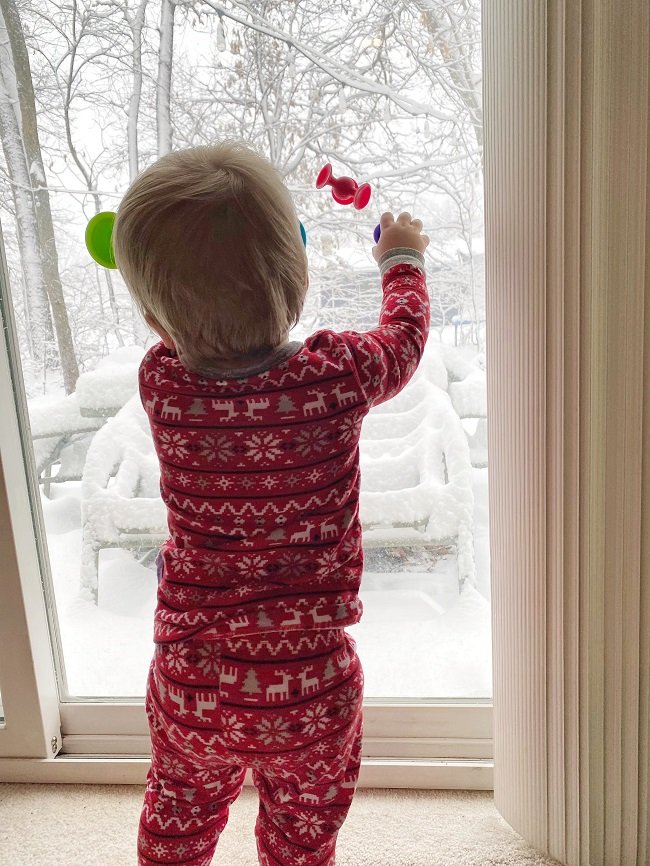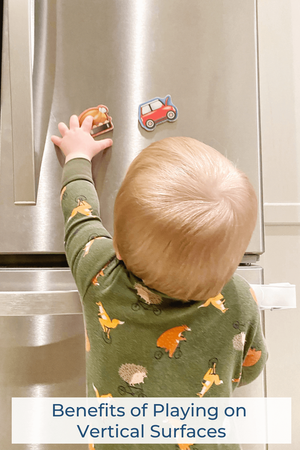Benefits of Playing On Vertical Surfaces
Disclaimer: this post may contain affiliate links from various sites, including Amazon. As a member of the Amazon associates program, we earn a small amount from qualifying purchases when you use our referral link. This does not add any additional cost to you and helps with the expenses of keeping in Life and Littles up and running.
If you’re anything like me, you spend entirely too much time looking down - staring down at my little one, scrolling through social media or working on my computer. Most kids these days are stuck in this same pattern. They play with their toys on the floor, work on schoolwork on their desks, color at the table, or watch videos on an iPad or other device. Especially in these frigid Michigan winters, when we’re stuck inside I have been making an effort to switch up our playtime activities. Playing on vertical surfaces is an easy way to change things up!
Encouraging your child to play on vertical surfaces in an easy and quick adjustment to make and offers many benefits:
· Increased muscle engagement - Playing on vertical surfaces helps kids strengthen the muscles in their hand, wrist, elbow, shoulder and upper back. Having the space to make large arm movements also increases upper body flexibility. Increased strength and flexibility = improved posture!
· Crossing Midline – Working on a large vertical surface requires kids to reach across their body to reach the entire surface. Crossing midline increases spatial awareness and increases bilateral coordination.
· Improved pencil grasp – Writing or coloring on a vertical surface naturally places the wrist in a stable position and helps with pencil grasp and writing control
· Sensory Integration – Do you have a kiddo that struggles to sit still to finish their work? Working on a vertical surface allows kids to stand and move their bodies while they work, which improves focus
· Core Strengthening – When kids sit in chairs they often slump against the back rest. When kids work or play on vertical surfaces, they do not have the support of a chair and must use their core to support themselves.
· Challenge Balance – For little ones who are learning to stand independently or walk, playing on vertical surfaces forces children to weight shift from side to side and front to back and helps them develop standing balance.
Playing on vertical surfaces is something that can easily be set up at home! If you have magnetic toys (like Magformers) have kids play with them on the refrigerator or dishwasher. If you have toys that stick to glass or other smooth surfaces (like Squigz) a sliding glass door or low windows make a great vertical surface to play on.
For older kiddos, try taping a coloring page or schoolwork to the wall and let them color or write. At the clinic, to encourage vertical play, we use butchers’ paper on a long wall, let kids create their own racetrack and run cars up and down the track! This is always a big hit. Having an easel provides a great portable vertical surface for older kiddos to benefit from too. They can use the easel to finger paint, color or complete schoolwork.
If you want to increase the challenge for your little one, try having them play in different positions. Standing requires core engagement but playing in tall kneeling or half-kneeling provides an added balance challenge and requires even more core work.
BONUS: Have your kid help with chores! Helping wash the car or washing windows with a squeegee are fun ways to encourage kids to work on a vertical surface with lots of sensory input (and get your house and car clean)




